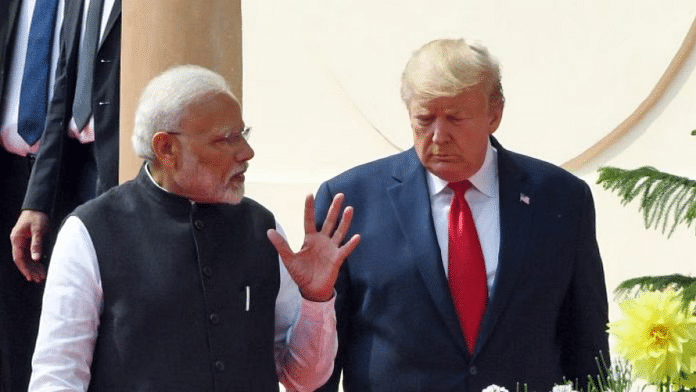The latest wave of US tariffs has hit Indian exporters where it hurts most. For garments, leather, gems and jewellery, a 50 per cent duty is not a marginal barrier; it is a virtual lockout from one of their most important markets. Orders are being cancelled, factories are scaling down, and competitors like Vietnam and Bangladesh have been quick to step into the breach. The consequences are visible in real terms—shrinking jobs, falling wages, and a current account deficit under fresh pressure.
In the immediate term, there are policy options. Expanding export credit lines, accelerating diversification to ASEAN and Africa, and extending relief to workers in distressed export clusters can soften the impact. Delhi must continue to engage with Washington for a trade deal, but only below-the-radar diplomacy can succeed.
For this, summit-level pronouncement and back-thumping have to be eschewed. But these are only temporary measures. The harsher truth is that India’s vulnerability to tariffs stems not only from US policy but also from deep-seated inefficiencies at home. The tariff shock has exposed a fragility we have long chosen to ignore.
Highest tariffs in the power sector
Consider the power sector. Indian industry pays among the highest tariffs in Asia, not because power is costlier to generate, but industries are forced to subsidise households and agriculture. In many states, they pay 30 to 40 per cent more than the cost of supply. Add transmission losses that average 20 per cent, and electricity becomes a hidden tax on exports.
Unless India adopts cost-reflective tariffs, with subsidies delivered through direct benefit transfers rather than being disguised in industrial tariffs, exporters will remain uncompetitive. Discom bailouts must be tied to efficiency, and annual tariff setting should be automatic and transparent. Without such reform, every Indian exporter carries an unnecessary burden.
Land is another cost factor. Industrial land in India is both expensive and unpredictable, often tied up in speculation and bureaucratic delays. Countries like Vietnam have leapfrogged us by creating industrial clusters where land is leased transparently, recycled after use, and supported by social infrastructure such as housing, schools, and hospitals. India too must recycle industrial land at the end of its life cycle, or once the unit shuts down, transitioning from virtual sale to leases tied to the project’s life, if it hopes to bring costs down and create export-friendly clusters.
Also read: Trump’s 100% pharma tariffs call for Indian firms to reimagine drug exports. Act quickly
Same scenario in transport, logistics
Transport and logistics tell a similar story. India’s freight costs are inflated because 45–55 per cent of petrol and diesel prices are taxes, including central excise and state levies. Rationalising these and aligning diesel with global benchmarks, offset by broadening the GST base, is essential to competitiveness. Logistics swallow up nearly 18 to 20 per cent of the cost of manufactured exports.
In Vietnam, the figure is 10 to 12 per cent; in Malaysia, 8 to 10 per cent. Trucks here cover only half the daily distance that they do in China or Vietnam. Port dwell times stretch to three to five days, compared with less than one day in Malaysia or Vietnam. Each inefficiency adds to the cost. This is why an Indian export leaves the factory gate with a cost disadvantage of 7-10 percentage points compared to competitors. The solution lies in seamless connectivity between industrial hubs, expressways, highways, railheads, and ports; in building modern warehouses, cold chains, and tech-driven logistics; and in ensuring that export clusters have schools, hospitals, and communication systems to attract and retain workers.
Even when goods are produced, firms must navigate a compliance maze. Despite digitisation, processes remain fragmented across ministries and states. Businesses spend weeks navigating portals, approvals and inspections. The GST regime, intended to simplify, has become too complex for small firms to manage without expert assistance. A unified National Compliance Grid, integrating central and state systems into a single digital workflow, is essential. Approvals must be algorithm-driven, with physical inspections reserved for genuine high-risk cases. The Rajasthan MSME (Facilitation & Development) Act 2019, which exempts small firms from multiple pre-establishment approvals, is a model worth emulating.
Ultimately, exporters cannot operate in an environment where access to raw materials is unpredictable. Cotton, gold, bulk drugs, agricultural produce—all are subject to sudden policy changes: export bans, duty hikes, stockholding restrictions. These abrupt shifts erode trust and prevent firms from entering long-term contracts. What is needed is a rolling five-year framework for inputs, notified by the Ministries of Commerce and Finance, that provides stability. Vietnam has done this for cotton to secure its textile exports; Malaysia has done so for palm oil. India cannot afford to continue with a stop-go approach. Stable and robust commodity forward markets are also necessary as export infrastructure.
The US tariffs are not an aberration; they are a wake-up call. India’s competitiveness cannot be defended abroad if it is eroded at home. Short-term measures can provide a cushion, but only structural reforms can build lasting resilience; without them, India’s exporters will remain perpetually vulnerable. The “Trump tantrum” is simply the messenger. The message is clear: reform is not optional. It is urgent and critical.
The author is a former finance secretary of the Government of India, a policy advisor and teaches public policy. He is also chairman of the Institute of Development Studies, Jaipur. Views are personal.
(Edited by Saptak Datta)






